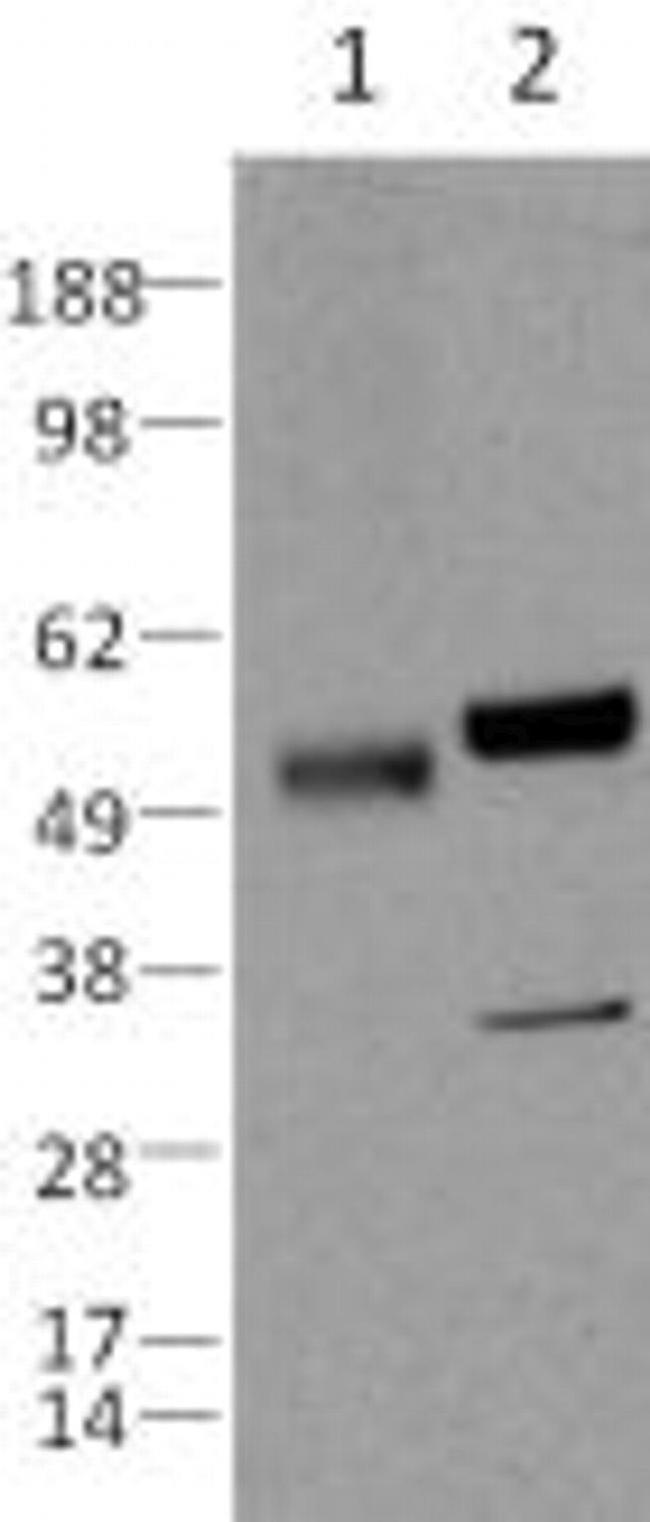Search Thermo Fisher Scientific
Product Details
14-9934-82
Species Reactivity
Host/Isotype
Class
Type
Clone
Conjugate
Form
Concentration
Purification
Storage buffer
Contains
Storage conditions
Shipping conditions
RRID
Product Specific Information
Description: The monoclonal antibody 1H10 recognizes human Caspase-8 also known as FLICE and MACH, a member of the cysteine-requiring aspartate protease family. Caspase-8 is an upstream caspase responsible for Fas and TNF-alpha mediated apoptosis. After activation of the Fas or TNF receptors by their ligands, the adaptor molecule FADD binds to the receptor and recruits caspase-8 to the membrane. The formation of this complex induces the cleavage and activation of caspase-8. The active form of caspase-8, made of a heterotetramer of p18 and p10, is released in the cytoplasm and activates downstream apoptotic proteases (caspase-3, -4, -6, -7, -9 and -10). Several (> 8) isoforms have been identified: 3 different pro-forms called Caspase-8a (55kDA), Caspase-8b (53kDa), and Caspase-8L which is procaspase-8 with an additional N-terminal extension of 59 aa.
The 1H10 antibody recognizes the p55 and p53 proforms in addition to the p43 and p18 cleaved forms. Under reducing conditions, an additional band (possibly non-specific) around 35kDa may be present. Under nonreducing conditions, this band is absent.
Applications Reported: This 1H10 antibody has been reported for use in immunoblotting (WB).
Applications Tested: This 1H10 antibody has been tested by immunoblot analysis of cell lines. This can be used at 1-5 µg/mL It is recommended that the antibody be carefully titrated for optimal performance in the assay of interest.
Purity: Greater than 90%, as determined by SDS-PAGE.
Aggregation: Less than 10%, as determined by HPLC.
Filtration: 0.2 µm post-manufacturing filtered.
Target Information
Caspase 8 (CASP8) is a member of the cysteine-aspartic acid protease (caspase) family. Sequential activation of caspases play a central role in the execution-phase of cell apoptosis. Caspases exist as inactive proenzymes composed of a pro-domain, a large protease subunit, and a small protease subunit. Activation of caspases requires proteolytic processing at conserved internal aspartic residues to generate a heterodimeric enzyme consisting of the large and small subunits. Caspase 8 is involved in the programmed cell death induced by Fas and various apoptotic stimuli. The N-terminal FADD-like death effector domain of Caspase 8 suggests that it may interact with Fas-interacting protein FADD. Caspase 8 was detected in the insoluble fraction of the affected brain region from Huntington disease patients but not in those from normal controls, which implicated the role in neurodegenerative diseases. Caspase 8 binds to the death effector domain (DED) of FADD through an analogous DED domain present in tandem in the pro-form of the Caspase 8 protein. Activated Caspase 8 then activates other downstream caspases including Caspase 9, thereby committing the cell to undergo apoptosis. In addition, Caspase 8 also reacts with Jurkat cells and Tonsil. Overexpression of Caspase 8 induces apoptosis, which can be blocked by inhibitors specific for the ICE family. Many alternatively spliced transcript variants encoding different isoforms have been described for Caspase 8, however, not all variants have had their full-length sequences determined.
For Research Use Only. Not for use in diagnostic procedures. Not for resale without express authorization.
References (0)
Bioinformatics
Protein Aliases: Apoptotic cysteine protease; Apoptotic protease Mch-5; CAP4; CASP-8; caspase 8, apoptosis-related cysteine peptidase; caspase 8, apoptosis-related cysteine protease; Caspase-8; Caspase-8 precursor; Caspase8; EC 3.4.22.61; FADD-homologous ICE/CED-3-like protease; FADD-like ICE; FLICE; FLJ17672; ICE-like apoptotic protease 5; ICE8; MACH; MACH-alpha-1/2/3 protein; MACH-beta-1/2/3/4 protein; MGC78473; MORT1-associated ced-3 homolog; OTTHUMP00000163720; OTTHUMP00000165063; OTTHUMP00000206557; OTTHUMP00000206581
Gene Aliases: ALPS2B; CAP4; Casp-8; CASP8; FLICE; MACH; MCH5
UniProt ID: (Human) Q14790
Entrez Gene ID: (Human) 841

Performance Guarantee
If an Invitrogen™ antibody doesn't perform as described on our website or datasheet,we'll replace the product at no cost to you, or provide you with a credit for a future purchase.*
Learn more
We're here to help
Get expert recommendations for common problems or connect directly with an on staff expert for technical assistance related to applications, equipment and general product use.
Contact tech support

